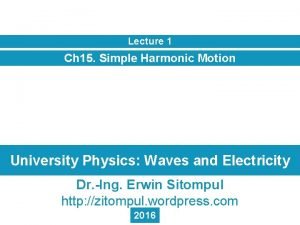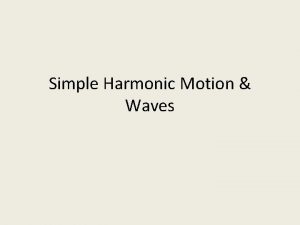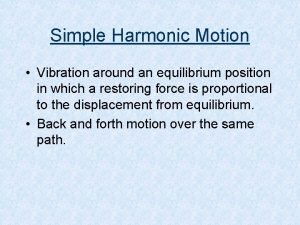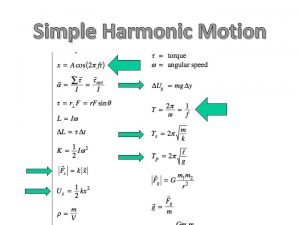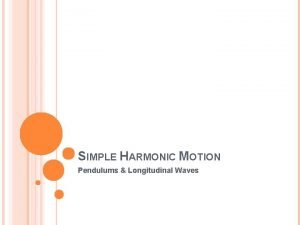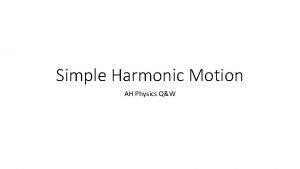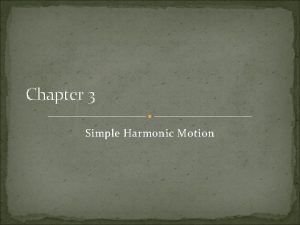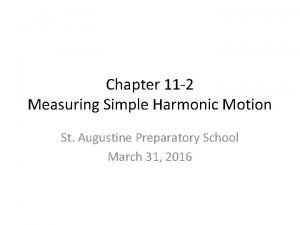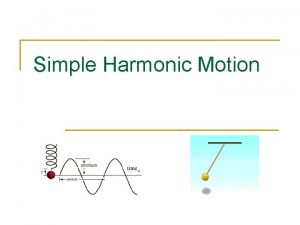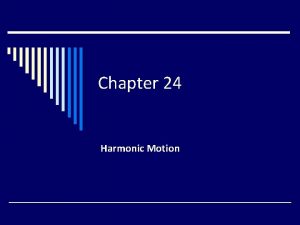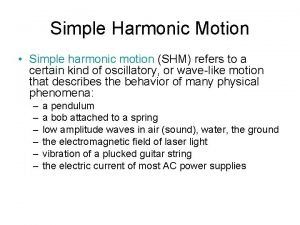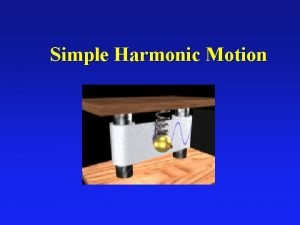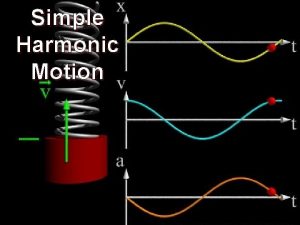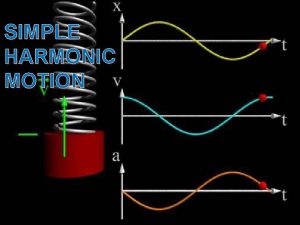Lecture 1 Ch 15 Simple Harmonic Motion University














- Slides: 14

Lecture 1 Ch 15. Simple Harmonic Motion University Physics: Waves and Electricity Dr. -Ing. Erwin Sitompul http: //zitompul. wordpress. com

Textbook and Syllabus Textbook: “Fundamentals of Physics”, Halliday, Resnick, Walker, John Wiley & Sons, 8 th Extended, 2008. Syllabus: (tentative) Chapter 15: Simple Harmonic Motion Chapter 16: Transverse Waves Chapter 17: Longitudinal Waves Chapter 21: Coulomb’s Law Chapter 22: Finding the Electric Field – I Chapter 23: Finding the Electric Field – II Chapter 24: Finding the Electric Potential Chapter 26: Ohm’s Law Chapter 27: Circuit Theory Erwin Sitompul University Physics: Waves and Electricity 1/2

Grade Policy: Final Grade = 5% Homework + 30% Quizzes + 30% Midterm Exam + 40% Final Exam + Extra Points § Homeworks will be given in fairly regular basis. The average of homework grades contributes 5% of final grade. § Homeworks are to be written on A 4 papers, otherwise they will not be graded. § Homeworks must be submitted on time. If you submit late, < 10 min. No penalty 10 – 60 min. – 40 points > 60 min. – 60 points § There will be 3 quizzes. Only the best 2 will be counted. The average of quiz grades contributes 30% of final grade. § Midterm and final exam schedule will be announced in time. § Make up of quizzes and exams will be held one week after the schedule of the respective quizzes and exams. Erwin Sitompul University Physics: Waves and Electricity 1/3

Lecture Activities § The lectures will be held every Tuesday and Wednesday: 17: 30 – 18: 30 : Class 17: 15 – 18: 15 18: 30 – 19: 00 : Break 18: 15 – 18: 45 19: 00 – 20: 45 : Class 18: 45 – 20: 30 § Lectures will be held in the form of Power. Point presentations. § You are expected to write a note along the lectures to record your own conclusions or materials which are not covered by the lecture slides. Erwin Sitompul University Physics: Waves and Electricity 1/4

Lecture Material § New lecture slides will be available on internet every Thursday afternoon. Please check the course homepage regularly. § The course homepage is : http: //zitompul. wordpress. com § You are responsible to read and understand the lecture slides. If there is any problem, you may ask me. § Quizzes, midterm exam, and final exam will be open-book. Be sure to have your own copy of lecture slides. § Extra points will be given if you solve a problem in front of the class. You will earn 1, 2, or 3 points. Erwin Sitompul University Physics: Waves and Electricity 1/5

Simple Harmonic Motion § The following figure shows a sequence of “snapshots” of a simple oscillating system. § A particle is moving repeatedly back and forth about the origin of an x axis. § One important property of oscillatory motion is its frequency, or number of oscillations that are completed each second. § The symbol for frequency is f, and its SI unit is the hertz (abbreviated Hz). 1 hertz = 1 Hz = 1 oscillation per second = 1 s– 1 Erwin Sitompul University Physics: Waves and Electricity 1/6

Simple Harmonic Motion § Related to the frequency is the period T of the motion, which is the time for one complete oscillation (or cycle). § Any motion that repeats itself at regular intervals is called periodic motion or harmonic motion. § We are interested here only in motion that repeats itself in a particular way, namely in a sinusoidal way. § For such motion, the displacement x of the particle from the origin is given as a function of time by: Erwin Sitompul University Physics: Waves and Electricity 1/7

Simple Harmonic Motion § This motion is called simple harmonic motion (SHM). § Means, the periodic motion is a sinusoidal function of time. § The quantity xm is called the amplitude of the motion. It is a positive constant. § The subscript m stands for maximum, because the amplitude is the magnitude of the maximum displacement of the particle in either direction. § The cosine function varies between ± 1; so the displacement x(t) varies between ±xm. Erwin Sitompul University Physics: Waves and Electricity 1/8

Simple Harmonic Motion § The constant ω is called the angular frequency of the motion. § The SI unit of angular frequency is the radian per second. To be consistent, the phase constant Φ must be in radians. Erwin Sitompul University Physics: Waves and Electricity 1/9

Simple Harmonic Motion Erwin Sitompul University Physics: Waves and Electricity 1/10

Checkpoint A particle undergoing simple harmonic oscillation of period T is at xm at time t = 0. Is it at –xm, at +xm, at 0, between –xm and 0, or between 0 and +xm when: (a) t = 2 T At +xm (b) t = 3. 5 T At –xm At 0 (c) t = 5. 25 T Between 0 and +xm (d) t = 2. 8 T ? 0. 5 T 1. 5 T T Erwin Sitompul University Physics: Waves and Electricity 1/11

Velocity and Acceleration of SHM § By differentiating the equation of displacement x(t), we can find an expression for the velocity of a particle moving with simple harmonic motion: § Knowing the velocity v(t) for simple harmonic motion, we can find an expression for the acceleration of the oscillating particle by differentiating once more: Erwin Sitompul University Physics: Waves and Electricity 1/12

Plotting The Motion Plot the following simple xm harmonic motions: 0 (a) x 1(t) = xm cosωt (b) x 2(t) = xm cos(ωt+π) –xm (c) x 3(t) = (xm/2) cosωt (d) x 4(t) = xm cos 2ωt x x 1(t) 0. 5 T T x 2(t) m 0 x 1(t) 0. 5 T T x 3(t) –xm xm 0 –xm Erwin Sitompul x 1(t) 0. 5 T T x 4(t) University Physics: Waves and Electricity 1/13

Homework 1: Plotting the Motions xm Plot the following simple harmonic motions in three different plots: 0 (a) xa(t) = xm cosωt (b) xb(t) = xm cos(ωt–π/2) –xm (c) xc(t) = xm/2 cos(ωt+π/2) xm (d) xd(t) = 2 xm cos(2ωt+π) 0 xa(t) 0. 5 T T xb(t)? xa(t) 0. 5 T T xc(t)? –xm xm 0 –xm Erwin Sitompul xa(t) 0. 5 T T xd(t)? University Physics: Waves and Electricity 1/14
 Simple harmonic motion lecture
Simple harmonic motion lecture Simple harmonic motion lecture
Simple harmonic motion lecture Shm formula
Shm formula First harmonic and second harmonic
First harmonic and second harmonic Simple harmonic motion vocabulary
Simple harmonic motion vocabulary Equilibrium position in shm
Equilibrium position in shm Spring constant simple harmonic motion
Spring constant simple harmonic motion Shm reference circle
Shm reference circle Simple harmonic motion formula
Simple harmonic motion formula Simple harmonic motion ap physics c
Simple harmonic motion ap physics c Shm
Shm Frequency of damped oscillation
Frequency of damped oscillation Simple harmonic motion formula
Simple harmonic motion formula Harmonic motion equation
Harmonic motion equation A 125 n object vibrates
A 125 n object vibrates
